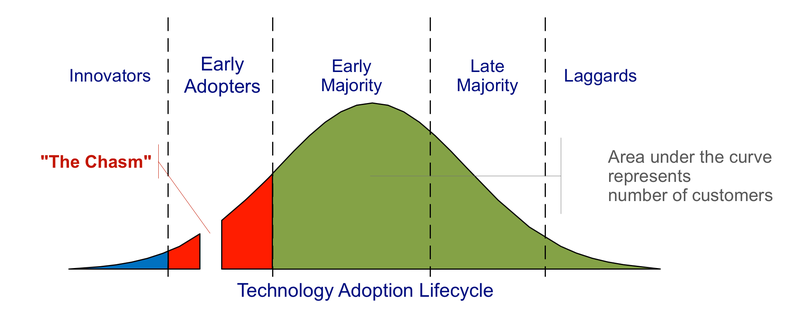 An IT vendor interviewed me recently about how satisfied I was with their services. I told them I was very satisfied. However, they were surprised to learn I had purchased several major systems from other vendors. When they asked why, I simply said, I was unaware that they offered similar capabilities, and that this was the first time anyone from their firm asked me about my business issues.
An IT vendor interviewed me recently about how satisfied I was with their services. I told them I was very satisfied. However, they were surprised to learn I had purchased several major systems from other vendors. When they asked why, I simply said, I was unaware that they offered similar capabilities, and that this was the first time anyone from their firm asked me about my business issues.
Geoffrey Moore’s Crossing the Chasm is a watershed book on product innovation and marketing. For those of you who are not familiar with the core concept, it essentially states that products go through lifecycles, and that buyers and clients, have different buying needs depending on where they are in that lifecycle. For example, in his classic diagram below,
 early adopters do not require the same level of support that the early majority needs. Early adopters can see how they can put a technology to use for their advantage and don’t need much support, while the early majority wants to know who else has it, how has it saved them money and will it have good support. Many new technologies fail to “cross the chasm” because they fail to recognize the change in buyers and needs. Marketers and sales people need to know this and need to be in alignment with each other and where their product or service is in the lifecycle.
early adopters do not require the same level of support that the early majority needs. Early adopters can see how they can put a technology to use for their advantage and don’t need much support, while the early majority wants to know who else has it, how has it saved them money and will it have good support. Many new technologies fail to “cross the chasm” because they fail to recognize the change in buyers and needs. Marketers and sales people need to know this and need to be in alignment with each other and where their product or service is in the lifecycle.
While crossing the chasm applies to technologies and products across an industry lifecycle, Stocking’s corollary is that it can also apply to a single customer or client. It’s not only the industry or technology that goes through a cycle, individual clients and customers do as well.
When you have offered a service or capability that solves a customer’s problem something happens. The customer now sees that your solution has solved a problem and can begin to focus on other problems or issues. They appreciate the solution less and less because, if it’s working, the problem is essentially solved. They may come to understand that other vendors offer similar technology more competitively and then begin to think about price. In short, they think, “What have you done for me lately?”
If you are concerned about the lifetime value of a client, you have to bring new ideas, services and products to your existing base, otherwise they are going to forget about you and go somewhere else. It’s surprising how often this happens. When it does, you’ll often find yourself driving into your own chasm.

Pingback: Would You Hire Stephen Hawking? | Prairie Sky Group
Pingback: People Don’t Read. What Are You Going To Do About It? | Prairie Sky Group